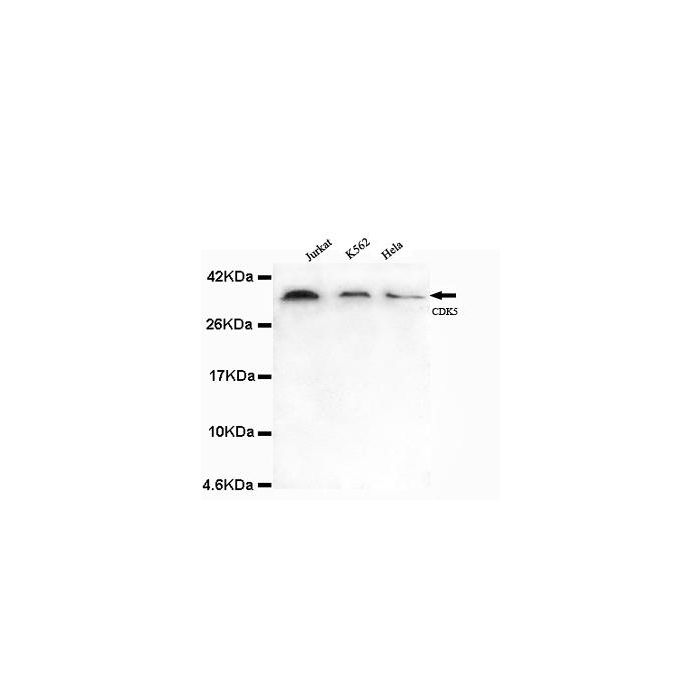CDK5 (N-terminus) (clone ), anti-human
€388.00
In stock
SKU
MB0101
Background:
Cell cycle progression is controlled in part by a family of cyclin proteins and cyclin dependent kinases (Cdks). Cdk proteins work in concert with the cyclins to phosphorylate key substrates involved in each phase of cell cycle progression. Another family of proteins, Cdk inhibitors, also plays a role in regulating cell cycle by binding to cyclin-Cdk complexes and modulating their activity. Several Cdk proteins have been identified, including Cdk2-Cdk8, PCTAIRE-1–3, PITALRE and PITSLRE. Cdk5 is thought to be involved in the G1-S transition of the cell cycle and is highly expressed in mature neurons. Activity of Cdk5 increases significantly during neuronal differentiation. Cdk5 has been postulated to be a neurofilament or tau protein kinase, based on its ability to phosphorylate these proteins in vitro.
Alternative Name:
Cdk 5, Cdk5, CDK5, Cell division protein kinase 5, Crk6, Cyclin dependent kinase 5, Cyclin-dependent kinase 5, Protein kinase CDK5 splicing, PSSALRE, Serine threonine protein kinase PSSALRE, Serine/threonine-protein kinase PSSALRE, Tau protein kinase II catalytic subunit, TPKII catalytic subunit,
Application Dilution: WB: 1:1000, ICC: 1:100~200
Specificity: This antibody detects endogenous levels of CDK5 and does not cross-react with related proteins
Immunogen:
Synthetic peptide, corresponding to the N-terminus of Human CDK5.
MW: Predicted band size: 36KDa , Observed band size: 36KDa
Swis Prot.: Q00535
Purification & Purity:
The antibody was affinity-purified from mouse ascites by affinity-chromatography using epitope-specific immunogen and the purity is > 95% (by SDS-PAGE).
Format:
Purified mouse monoclonal in buffer containing 0.1M Tris-Glycine (pH 7.4, 150 mM NaCl) with 0.2% sodium azide, 50%,glycerol
Storage:
Store at 4°C short term. Aliquot and store at -20°C long term. Avoid freeze-thaw cycles.
For research use only, not for use in diagnostic procedure.
Cell cycle progression is controlled in part by a family of cyclin proteins and cyclin dependent kinases (Cdks). Cdk proteins work in concert with the cyclins to phosphorylate key substrates involved in each phase of cell cycle progression. Another family of proteins, Cdk inhibitors, also plays a role in regulating cell cycle by binding to cyclin-Cdk complexes and modulating their activity. Several Cdk proteins have been identified, including Cdk2-Cdk8, PCTAIRE-1–3, PITALRE and PITSLRE. Cdk5 is thought to be involved in the G1-S transition of the cell cycle and is highly expressed in mature neurons. Activity of Cdk5 increases significantly during neuronal differentiation. Cdk5 has been postulated to be a neurofilament or tau protein kinase, based on its ability to phosphorylate these proteins in vitro.
Alternative Name:
Cdk 5, Cdk5, CDK5, Cell division protein kinase 5, Crk6, Cyclin dependent kinase 5, Cyclin-dependent kinase 5, Protein kinase CDK5 splicing, PSSALRE, Serine threonine protein kinase PSSALRE, Serine/threonine-protein kinase PSSALRE, Tau protein kinase II catalytic subunit, TPKII catalytic subunit,
Application Dilution: WB: 1:1000, ICC: 1:100~200
Specificity: This antibody detects endogenous levels of CDK5 and does not cross-react with related proteins
Immunogen:
Synthetic peptide, corresponding to the N-terminus of Human CDK5.
MW: Predicted band size: 36KDa , Observed band size: 36KDa
Swis Prot.: Q00535
Purification & Purity:
The antibody was affinity-purified from mouse ascites by affinity-chromatography using epitope-specific immunogen and the purity is > 95% (by SDS-PAGE).
Format:
Purified mouse monoclonal in buffer containing 0.1M Tris-Glycine (pH 7.4, 150 mM NaCl) with 0.2% sodium azide, 50%,glycerol
Storage:
Store at 4°C short term. Aliquot and store at -20°C long term. Avoid freeze-thaw cycles.
For research use only, not for use in diagnostic procedure.
| Is Featured? | No |
|---|
Write Your Own Review

